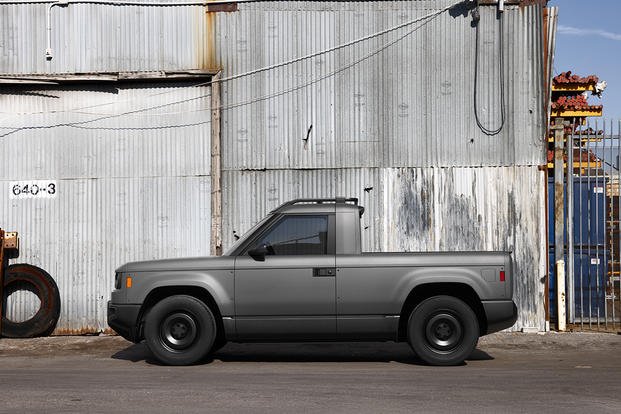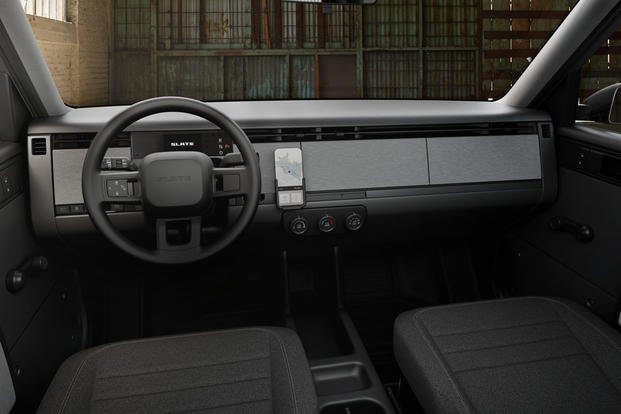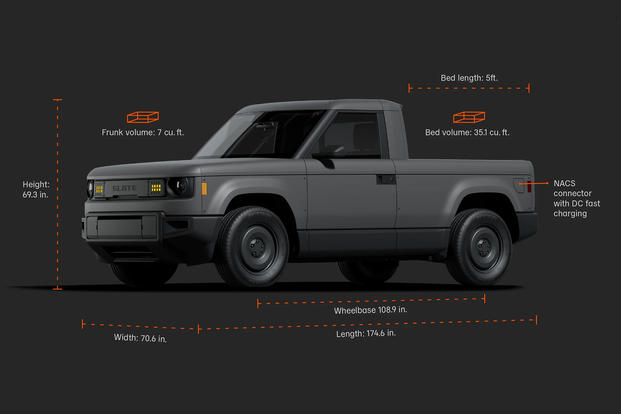Jordan’s Bulls. The Belichick-Brady Patriots. A midsize Toyota pickup with a bed full of flip-flops and a PKM. These are the dynasties we came to accept as the natural order -- and they’ve all met their end.
Fans of technicals -- civilian vehicles converted for combat use -- know that not much has changed since the days of M16A2 iron sights and chocolate chip camo. The same Toyotas that roamed the streets of Mogadishu in the 1990s are still puttering around the Middle East today (no, really, the same actual vehicles, likely without so much as an oil change).

But the other morning, I woke up, started flipping through the news and saw that a company I’d never heard of had just pulled the curtain on what looks like an all-electric version of the technicals I saw in Afghanistan.
The company is Slate. The vehicle is a teeny, tiny electric pickup truck. But the delightfully refreshing design philosophy reminds me more of a farm truck or, yes, a technical than the current crop of generic eco-friendly/sports/luxury/family-hauling crossovers.
Read Next: V-Twins, Veterans and Riding for a Cause: The 2025 Indian Motorcycle National Charity Ride
Old Trucks Are Back to the Future

Grumpy car enthusiasts (like me) keep complaining because new cars are too complicated, too disconnected from the driving experience and way too expensive. The same goes for pickup trucks, which are now basically a luxury status symbol for a large portion of customers.
How is someone without the backing of the U.S. military-industrial complex supposed to make ends meet?
The Slate pickup is an EV, but it rejects the idea that more is better.

Want infotainment? Bring your own. The truck’s blank dash has room for you to mount a phone or tablet that’s always updated with the latest apps. There aren’t even speakers. You can add them as an option or hang a Bluetooth speaker beneath the climate control panel (and by that, I mean three physical knobs for fan speed, temperature and vent selection).
The potential for customization goes far beyond electronic devices, though. Slate trucks are gray -- period -- but they’ll wrap the exterior for you in all kinds of wild colors and patterns. Try it out in Slate’s online configurator!

You can even mix and match body panels to change the vehicle from a pickup to an SUV, to an open-top desert runner right in your own driveway.
The single 150-kilowatt motor (good for 201 horsepower) only powers the rear wheels, which limits off-road potential (although it is rear-mounted, so it should have better grip than a conventional two-wheel-drive truck). The upside is that it’s simpler and cheaper to build.
The website promises that “if you can charge a phone, you can charge a Slate.”

The included Level 1 charger will add 2-5 miles of range per hour from a standard 110-volt wall outlet (20-50 miles overnight). The Level 2 charger ups that to somewhere from 25-40 miles of range per hour from a 240-volt appliance outlet -- enough for a full charge in 4-8 hours. If you use a public charging station, you can expect to get a 20%-80% charge in 30 minutes.
The standard battery has a projected range of 150 miles, but you can upgrade to a larger battery with a 240-mile projected range. Naturally, there’s an app that lets you track battery performance and find charging options as you go.
No, Slate is not going to beat a Tesla, Porsche Taycan or Ford Mustang Mach-E in performance -- but it clobbers all of them in terms of affordability. Most EVs only get used for local trips, anyway, and this truck should be able to handle that.
What the Heck Is Slate?
New automakers are always exciting, but you’re probably wondering whether Slate will survive long enough to actually put trucks on the road.

Some EV upstarts, such as Tesla and Rivian, have made it work. Others, such as Canoo, are now as dead as an uncharged battery.
Slate has one serious advantage. Its financial backers include Jeff Bezos and a few other investors who helped the company raise $111 million, according to a filing with the U.S. Securities and Exchange Commission.
At the very least, the Slate pickup will have to be more popular than sending Katy Perry to space, right?
Want One? Get in Line

I joke about this being a technical for the modern age, but I’m serious when I say Slate could be a military game-changer.
No, it’s not going to replace the ISV on the front lines. It may -- and hopefully will -- start making appearances on military installations as a privately owned vehicle, though.
Young service members often save up their first few months’ paychecks for a down payment on their first adult purchase: a car. Unfortunately, they usually have to choose between a predatory used-car lot just outside the main gate or a new vehicle with a price so high that it makes the Space Force’s morning intelligence brief.
As I write this, the MSRP for a 2025 Toyota Tacoma is $31,590, and a lieutenant-spec 4Runner TRD Pro will set you back $66,900. The cheapest Ford F-150, a two-door XL, starts at $38,810.

And the Slate? After federal EV incentives, Slate anticipates that customers will pay less than $20,000. That undercuts the comparable 2025 Ford Maverick XL by more than $6,000, and owners won’t have to pay to maintain a complicated hybrid system.
And that’s the catch. Notice that I said Slate anticipates the price to be less than $20,000 because vehicles won’t be available for purchase until model year 2027. If you want to get in line, you can reserve one now for $50.

There are a lot of unanswered questions about this truck, and I’m very curious to read road-test results or try one for myself, but the early signs are extremely good.
Military installations are working to make EV charging easier for service members. I’m delighted to see something that can provide junior enlisted ranks with a safe, modern vehicle that won’t saddle them with debt for the rest of their career.
If Slate can pull this off, it could be a fantastic military victory -- technically.
Want to Know More About the Military?
Be sure to get the latest news about the U.S. military, as well as critical info about how to join and all the benefits of service. Subscribe to Military.com and receive customized updates delivered straight to your inbox.











